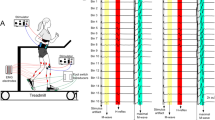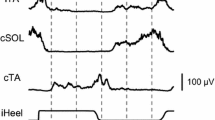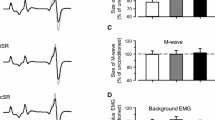Abstract
The aim of this study was to investigate the contribution of proprioceptive feedback to the amplitude modulation of the soleus muscle activity during human walking. We have previously shown that slow-velocity, small-amplitude ankle dorsiflexion enhancements and reductions applied during the stance phase of the step cycle generate, respectively, increments and decrements on the ongoing soleus activity. We have also shown that the increments in soleus activity are at least partially mediated by feedback from group Ia fibres. In the present study, we further investigated the afferent-mediated contribution from muscle group II afferents, cutaneous and proprioceptive afferents from the foot, and load-sensitive afferents to the soleus EMG. Slow-velocity, small-amplitude ankle trajectory modifications were combined with the pharmaceutical depression of group II polysynaptic pathways with tizanidine hydrochloride, anaesthetic blocking of sensory information from the foot with injections of lidocaine hydrochloride, and modulation of load feedback by increasing and decreasing the body load. The depression of the group II afferents significantly reduced the soleus response to the ankle trajectory modifications. Blocking sensory feedback from the foot did not have an effect on the soleus muscle activity. Changes in body load affected the ongoing soleus activity level; however, it did not affect the amplitude of the soleus EMG responses to the ankle trajectory modifications. These results suggest that the feedback from group II afferents, and possibly from load-sensitive afferents, contribute to the amplitude modulation of the soleus muscle activity during the stance phase of the step cycle. However, feedback from cutaneous afferents and instrinsic proprioceptive afferents from the foot does not seem to contribute to this muscle activation.






Similar content being viewed by others
References
Andersen JB, Sinkjaer T (1995) An actuator system for investigating electrophysiological and biomechanical features around the human ankle joint during gait. IEEE Trans Rehabil Eng 3:299–306
Bras H, Jankowska E, Noga B, Skoog B (1990) Comparison of effects of various types of NA and 5-HT agonists on transmission from group II muscle afferents in the cat. Eur J Neurosci 2(12):1029–1039
Conway BA, Hultborn H, Kiehn O (1987) Proprioceptive input resets central locomotor rhythm in the spinal cat. Exp Brain Res 68:643–656
Corna S, Grasso M, Nardone A, Schieppati M (1995) Selective depression of medium-latency leg and foot muscle responses to stretch by an alpha 2-agonist in humans. J Physiol 484(3):803–809
Davies J, Johnston SE, Hill DR, Quinlan JE (1984) Tizanidine (DS103–282), a centrally acting muscle relaxant, selectively depresses excitation of feline dorsal horn neurones to noxious peripheral stimuli by an action at alpha 2-adrenoceptors. Neurosci Lett 48:197–202
Dietz V, Quintern J, Sillem M (1987) Stumbling reactions in man: significance of proprioceptive and pre-programmed mechanisms. J Physiol 386:149–163
Donelan JM, Pearson KG. (2004) Contribution of force feedback to ankle extensor activity in decerebrate walking cats. J Neurophysiol 92:2093–2104
Duysens J, Tax AA, Trippel M, Dietz V (1992) Phase-dependent reversal of reflexly induced movements during human gait. Exp Brain Res 90(2):404–414
Duysens J, Clarac F, Cruse H (2000) Load-regulating mechanisms in gait and posture: comparative aspects. Physiol Rev 80:83–133
Edgley SA, Jankowska E, Shefchyk S (1988) Evidence that mid-lumbar neurones in reflex pathways from group II afferents are involved in locomotion in the cat. J Physiol 403:57–71
Enriquez-Denton M, Morita H, Christensen LO, Petersen N, Sinkjaer T, Nielsen JB (2002) Interaction between peripheral afferent activity and presynaptic inhibition of Ia afferents in the cat. J Neurophysiol. 88(4):1664–1674
Finch L, Barbeau H, Arsenault B (1991) Influence of body weight support on normal human gait: development of a gait retraining strategy. Phys Ther 71:842–855
Grey MJ, Ladouceur M, Andersen JB, Nielsen JB, Sinkjaer T (2001) Group II muscle afferents probably contribute to the medium latency soleus stretch reflex during walking in humans. J Physiol 534:925–933
Grey MJ, van Doornik J, Sinkjaer T (2002) Plantar flexor stretch reflex responses to whole body loading/unloading during human walking. Eur J Neurosci 16:2001–2007
Grey MJ, Mazzaro N, Nielsen JB, Sinkjaer T (2004) Ankle extensor proprioceptors contribute to the enhancement of the soleus EMG during the stance phase of human walking. Can J Physiol Pharmacol 82:610–616
Hammar I, Jankowska E (2003) Modulatory effects of alpha1-,alpha2-, and beta -receptor agonists on feline spinal interneurons with monosynaptic input from group I muscle afferents. J Neurosci 23:332–338
Harkema SJ, Hurley SL, Patel UK, Requejo PS, Dobkin BH, Edgerton VR (1997) Human lumbosacral spinal cord interprets loading during stepping. J Neurophysiol 77:797–811
Hiebert GW, Pearson KG (1999) Contribution of sensory feedback to the generation of extensor activity during walking in the decerebrate Cat. J Neurophysiol 81(2):758–770
Jankowska E, Lackberg ZS, Dyrehag LE (1994) Effects of monoamines on transmission from group II muscle afferents in sacral segments in the cat. Eur J Neurosci 6:1058–1061
Jankowska E, Gladden MH, Czarkowska-Bauch J (1998) Modulation of responses of feline gamma-motoneurones by noradrenaline, tizanidine and clonidine. J Physiol 512(2):521–531
Matthews PB (1991) The human stretch reflex and the motor cortex. Trends Neurosci 14:87–91
Mazzaro N, Grey MJ, Sinkjær T (2005a) Contribution of afferent feedback to the soleus muscle activity during human locomotion. J Neurophysiol 93(1):167–177
Mazzaro N, Grey MJ, Sinkjær T, Andersen JB, Pareyson D, Schieppati M (2005b) Lack of on-going muscle adaptation in the soleus muscle activity during walking in patients affected by large-fiber neuropathy. J Neurophysiol 93(6):3075–3085
Morita H, Petersen N, Christensen LO, Sinkjaer T, Nielsen JB (1998) Sensitivity of H-reflexes and stretch reflexes to presynaptic inhibition in humans. J Neurophysiol 80(2):610–620
Nielsen JB, Sinkjaer T (2002) Afferent feedback in the control of human gait. J Electromyogr Kinesiol 12(3):213–217
Nurse MA, Nigg BM (2001) The effect of changes in foot sensation on plantar pressure and muscle activity. Clin Biomech 16:719–727
Pearson KG (2004) Generating the walking gait: role of sensory feedback. Prog Brain Res 143:123–129
Pearson KG, Ramirez JM, Jiang W (1992) Entrainment of the locomotor rhythm by group Ib afferents from ankle extensor muscles in spinal cats. Exp Brain Res 90:557–566
Pearson KG, Misiaszek JE, Fouad K (1998) Enhancement and resetting of locomotor activity by muscle afferents. Ann N Y Acad Sci 860:203–215
Prochazka A, Westerman RA, Ziccone SP (1976) Discharges of single hindlimb afferents in the freely moving cat. J Neurophysiol 39:1090–1104
Schieppati M, Nardone A (1997) Medium-latency stretch reflexes of foot and leg muscles analysed by cooling the lower limb in standing humans. J Physiol 503(3):691–698
Sinkjaer T, Andersen JB, Larsen B (1996) Soleus stretch reflex modulation during gait in humans. J Neurophysiol 76:1112–1120
Sinkjaer T, Andersen JB, Ladouceur M, Christensen LO, Nielsen JB (2000) Major role for sensory feedback in soleus EMG activity in the stance phase of walking in man. J Physiol 523(3):817–827
Stephens MJ, Yang JF (1999) Loading during the stance phase of walking in humans increases the extensor EMG amplitude but does not change the duration of the step cycle. Exp Brain Res 124:363–370
Taylor J, Stein RB, Murphy PR (1985) Impulse rates and sensitivity to stretch of soleus muscle spindle afferent fibers during locomotion in premammillary cats. J Neurophysiol 53:341–360
Whelan PJ, Hiebert GW, Pearson KG (1995) Stimulation of the group I extensor afferents prolongs the stance phase in walking cats. Exp Brain Res 103:20–30
Yang JF, Stein RB, James KB (1991) Contribution of peripheral afferents to the activation of the soleus muscle during walking in humans. Exp Brain Res 87:679–687
Zehr EP, Stein RB (1999) What functions do reflexes serve during human locomotion? Prog Neurobiol 58(2):185–205
Acknowledgements
The authors thank Dr. Jacob Buus Andersen, Mr. Jan Stavnshøj, and Mr. Knud Larsen for their technical assistance. M. D. Jens Haase is acknowledged for performing the ankle blocks. This study was funded by a grant from the Danish National Research Foundation.
Author information
Authors and Affiliations
Corresponding author
Rights and permissions
About this article
Cite this article
Mazzaro, N., Grey, M.J., do Nascimento, O.F. et al. Afferent-mediated modulation of the soleus muscle activity during the stance phase of human walking. Exp Brain Res 173, 713–723 (2006). https://doi.org/10.1007/s00221-006-0451-5
Received:
Accepted:
Published:
Issue Date:
DOI: https://doi.org/10.1007/s00221-006-0451-5




